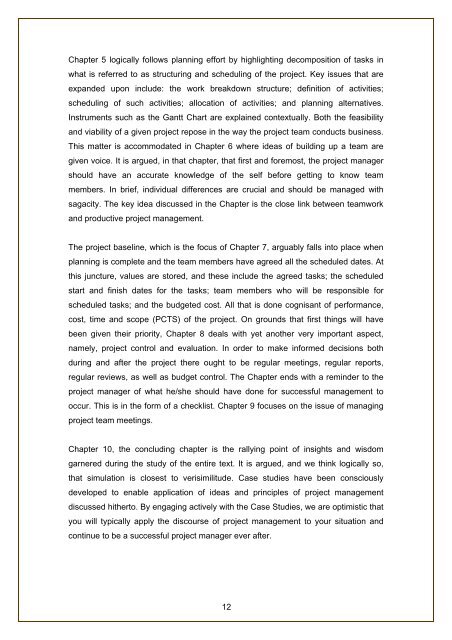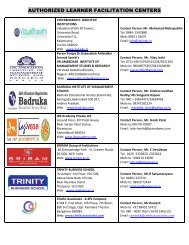successful project management - Commonwealth of Learning
successful project management - Commonwealth of Learning
successful project management - Commonwealth of Learning
You also want an ePaper? Increase the reach of your titles
YUMPU automatically turns print PDFs into web optimized ePapers that Google loves.
Chapter 5 logically follows planning effort by highlighting decomposition <strong>of</strong> tasks in<br />
what is referred to as structuring and scheduling <strong>of</strong> the <strong>project</strong>. Key issues that are<br />
expanded upon include: the work breakdown structure; definition <strong>of</strong> activities;<br />
scheduling <strong>of</strong> such activities; allocation <strong>of</strong> activities; and planning alternatives.<br />
Instruments such as the Gantt Chart are explained contextually. Both the feasibility<br />
and viability <strong>of</strong> a given <strong>project</strong> repose in the way the <strong>project</strong> team conducts business.<br />
This matter is accommodated in Chapter 6 where ideas <strong>of</strong> building up a team are<br />
given voice. It is argued, in that chapter, that first and foremost, the <strong>project</strong> manager<br />
should have an accurate knowledge <strong>of</strong> the self before getting to know team<br />
members. In brief, individual differences are crucial and should be managed with<br />
sagacity. The key idea discussed in the Chapter is the close link between teamwork<br />
and productive <strong>project</strong> <strong>management</strong>.<br />
The <strong>project</strong> baseline, which is the focus <strong>of</strong> Chapter 7, arguably falls into place when<br />
planning is complete and the team members have agreed all the scheduled dates. At<br />
this juncture, values are stored, and these include the agreed tasks; the scheduled<br />
start and finish dates for the tasks; team members who will be responsible for<br />
scheduled tasks; and the budgeted cost. All that is done cognisant <strong>of</strong> performance,<br />
cost, time and scope (PCTS) <strong>of</strong> the <strong>project</strong>. On grounds that first things will have<br />
been given their priority, Chapter 8 deals with yet another very important aspect,<br />
namely, <strong>project</strong> control and evaluation. In order to make informed decisions both<br />
during and after the <strong>project</strong> there ought to be regular meetings, regular reports,<br />
regular reviews, as well as budget control. The Chapter ends with a reminder to the<br />
<strong>project</strong> manager <strong>of</strong> what he/she should have done for <strong>successful</strong> <strong>management</strong> to<br />
occur. This is in the form <strong>of</strong> a checklist. Chapter 9 focuses on the issue <strong>of</strong> managing<br />
<strong>project</strong> team meetings.<br />
Chapter 10, the concluding chapter is the rallying point <strong>of</strong> insights and wisdom<br />
garnered during the study <strong>of</strong> the entire text. It is argued, and we think logically so,<br />
that simulation is closest to verisimilitude. Case studies have been consciously<br />
developed to enable application <strong>of</strong> ideas and principles <strong>of</strong> <strong>project</strong> <strong>management</strong><br />
discussed hitherto. By engaging actively with the Case Studies, we are optimistic that<br />
you will typically apply the discourse <strong>of</strong> <strong>project</strong> <strong>management</strong> to your situation and<br />
continue to be a <strong>successful</strong> <strong>project</strong> manager ever after.<br />
12
















